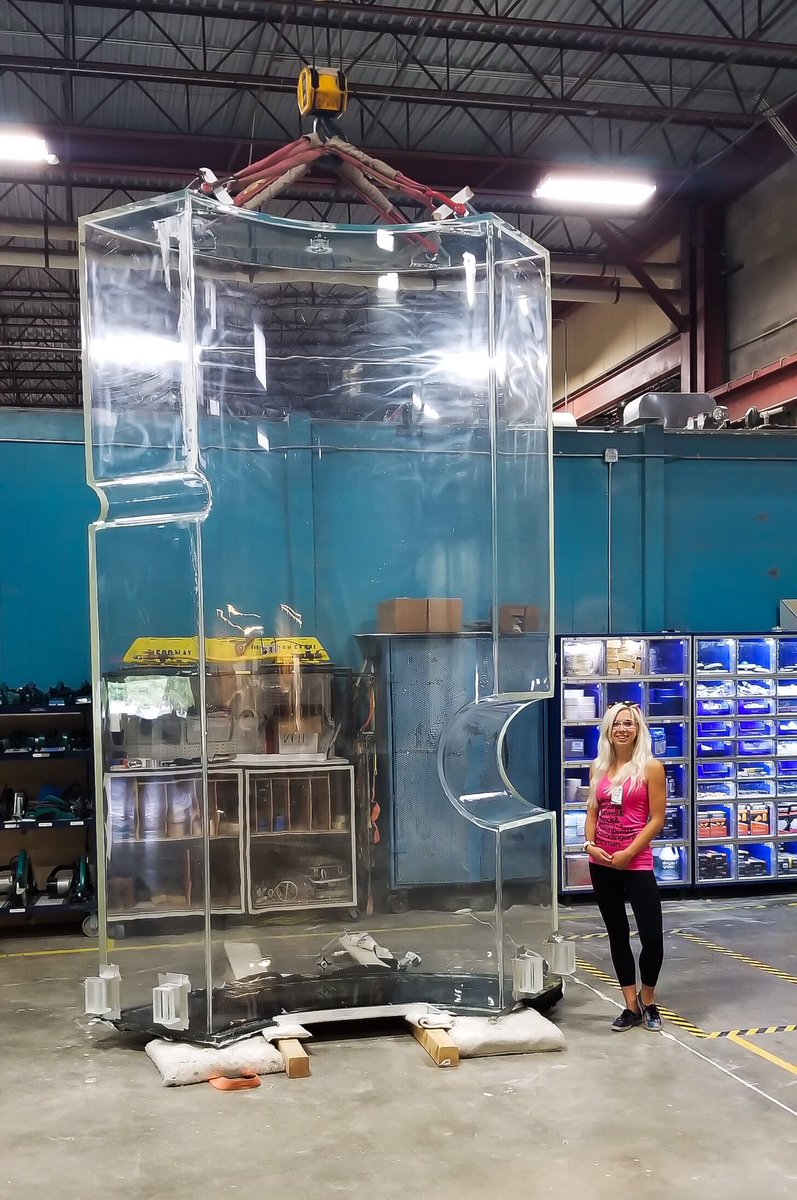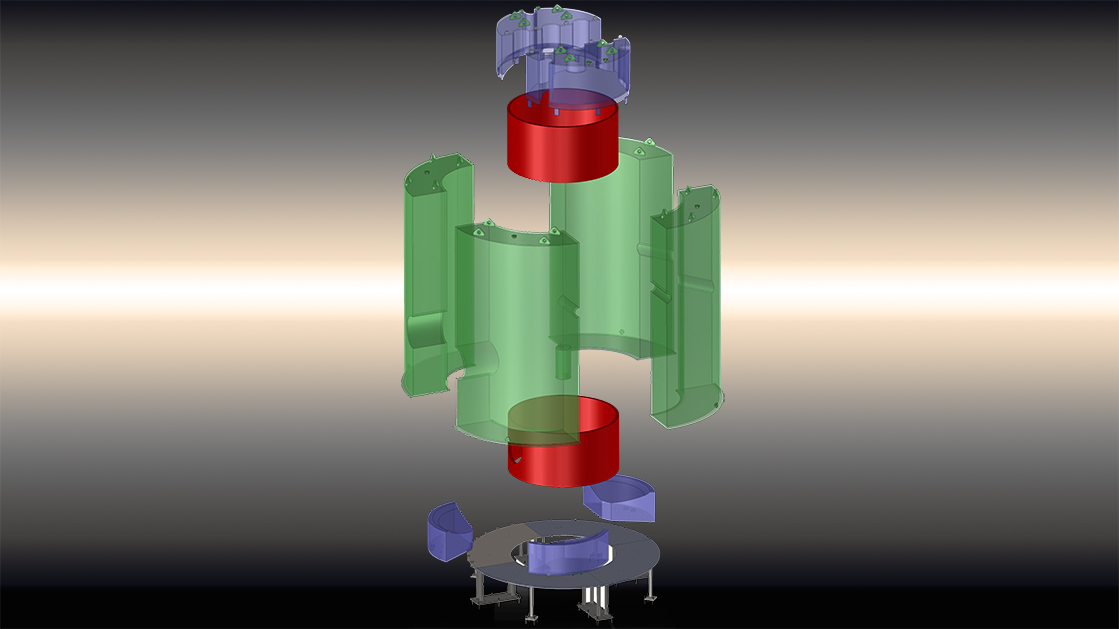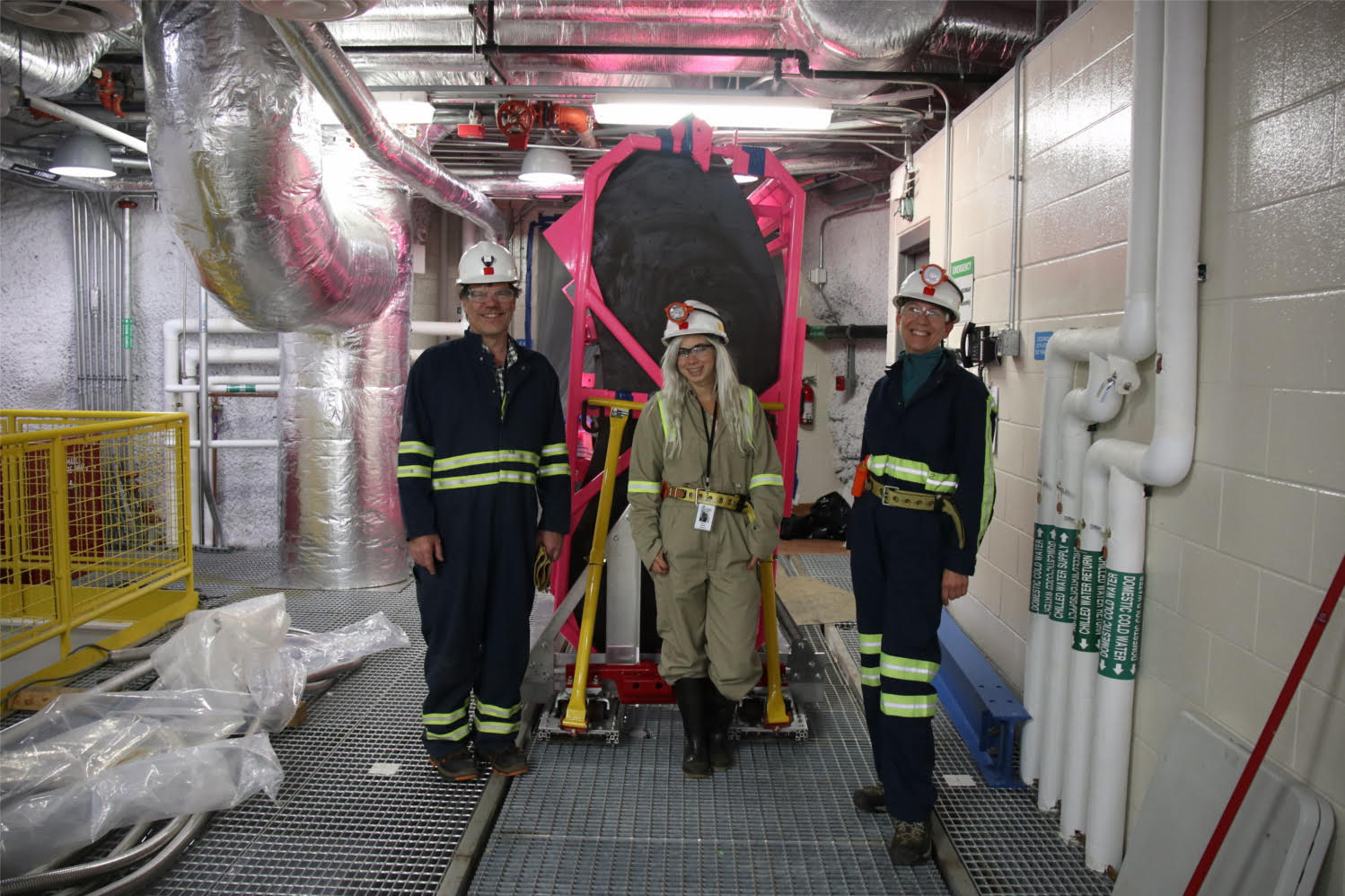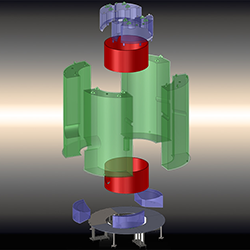— Glenn Roberts Jr.

Sally Shaw, a UC Santa Barbara postdoctoral researcher, stands beside a 12-foot-tall acrylic tank at a manufacturing site in Colorado. The tank was built for the LUX-ZEPLIN dark matter search experiment now under construction in Lead, South Dakota. (Credit: LZ Collaboration)
Scientists have a new window into the search for dark matter – an acrylic vessel that features a grouping of 12-foot-tall transparent tanks with 1-inch-thick walls.
The tanks, which will surround a central detector for a nearly mile-deep experiment under construction in South Dakota called LUX-ZEPLIN (LZ), will be filled with liquid that produces tiny flashes of light in some particle interactions.
Scientists will track these flashes of light with a data-acquisition system and reconstruct their likely sources. In addition to holding the liquid scintillator, the tanks will also serve as a shield for some unwanted particle “noise” that could interfere with other, sought-after signals, and as a veto system – a sort of lie detector that can help scientists sort out false detections of dark matter from a real discovery.
Dark matter, which makes up an estimated 85 percent of all matter in the universe, has never been seen directly, though scientists detect its presence through gravitational effects. The stars in spiral galaxies, for example, have been observed to move around the center at about the same rate even at very different distances, which tells scientists there is something else in play that causes this unexpected effect.
While we don’t know what dark matter is composed of, the LZ experiment is designed to hunt for one of the prime suspects – a theorized particle known as a WIMP, or weakly interacting massive particle.
An international collaboration, involving about 250 scientists, engineers, and technicians from 38 institutions, is working on LZ. The U.S. Department of Energy’s Lawrence Berkeley National Laboratory (Berkeley Lab) oversees LZ construction and installation. The LZ experiment is expected to begin taking data in 2020.
LZ’s acrylic tanks were fashioned in segments in order to fit down the elevator shaft at the Sanford Underground Research Facility (SURF), a former gold mine in Lead, South Dakota. LZ will occupy a newly renovated cavern at SURF that was formerly home to its smaller predecessor, the LUX (Large Underground Xenon) experiment.
LZ is designed to be at least 100 times more sensitive to possible dark matter particle signals than LUX. The veto system formed by the acrylic tanks and a related sequence of light-sensing detectors will improve LZ’s ability to rule out non-dark-matter signals.
LZ’s four largest acrylic tanks, which are custom-designed and contoured, measure 12.3 feet tall, 7.5 feet wide, and 3.4 feet thick, and weigh 1,500 pounds apiece. Two arrived at SURF earlier this month, and the other two will be delivered within the next month. Six smaller tanks – three that will sit atop the main detector and three that will reside below it – will arrive by the end of the year.

A diagram showing the components of the acrylic tanks veto system for the LUX-ZEPLIN experiment. The green and blue objects represent the clear acrylic tanks. They will be fitted snugly together and held by a metal base. (Credit: LZ Collaboration)
“It looks like a giant lightsaber cut into quarters from the top,” said Harry Nelson, a UC Santa Barbara physics professor who oversees the acrylic tanks effort for LZ. Nelson compares the tanks to one of mythical light swords featured in the “Star Wars” science-fiction films. UC Santa Barbara has served as the technical lead for the tanks, overseeing their design, commercial fabrication, testing, and transportation.
Researchers designed a special frame to support and protect the tanks that will allow workers to maneuver the tanks through the complex of tunnels to their resting place. A special rigging attached to this frame will be used to suspend each of the large tank components below the elevator at SURF for their journey underground. “Each segment will be hung like a holiday ornament from the bottom of the elevator,” Nelson said.
Simon Fiorucci, a Berkeley Lab physicist who oversees LZ operations at SURF, said, “This is the first instance of significant LZ detector equipment installation in the underground laboratory. It is a major milestone for the project, and it bodes very well for the busy year ahead of us.”
Other physics experiments have also used acrylic for holding tanks, Nelson noted, including the Sudbury Neutrino Observatory’s 12-foot spherical vessel in Ontario, Canada.
In total, the 10 tanks that will surround the cylindrical central detector at LZ will hold about 17 tons of a liquid scintillator known as linear alkylbenzene, which is more commonly used as an ingredient in detergents and other cleaning products. The central cylindrical detector is built with ultrahigh-purity titanium and will contain 10 tons of ultrapurified liquid xenon, a rare element whose atoms can emit bursts of light in particle interactions.
“Recent dark matter searches have found that neutrons can be a pernicious background, with the ability to mimic a dark matter signal,” said Carter Hall, LZ spokesperson and physics professor at the University of Maryland. Neutrons are particles with no charge that reside in atomic nuclei. “The acrylic tanks and their liquid scintillator payload will provide a powerful neutron rejection signal so that LZ is not fooled.”
Like layers of an onion, the acrylic tanks will fit snugly around the central LZ detector and will themselves be surrounded by a large tank holding about 60,000 gallons (230 tons) of ultrapure water.
“Everything must fit together within a quarter-inch tolerance,” said Sally Shaw, a UC Santa Barbara postdoctoral researcher who has been working to ensure the tanks meet the rigorous requirements of the LZ experiment.
The tanks were each cleaned from the inside out prior to shipping to the SURF site, she noted.
“Any radioactivity inside the tanks will create light,” she said. “There is a procedure that involves wiping them down with solvents. Then we use deionized water and special cleaning powder, with someone lying down inside the tanks. It involves lots and lots of rinsing, and testing the purity of the rinsed water. It’s a big job.”

A sturdy, custom-designed pink frame holds one of the 12-foot-tall acrylic tanks. (Credit: LZ Collaboration)
UC Santa Barbara researchers worked closely with the tanks’ manufacturer, Reynolds Polymer Technology in Grand Junction, Colo., to design and engineer the sturdy frames used to protect the tanks during transport. The frames were painted pink, Shaw’s favorite color, in recognition of her many contributions to the project.
LZ researchers embarked on many trips to the site of the tanks’ manufacturing site to oversee the process at various stages.
After all of the tanks are lowered to the research cavern and into the empty water tank where LZ will be installed, they will remain in protective wrapping until the final stages of assembly in late 2019.
For more information about LZ and the LZ collaboration, visit: lz.lbl.gov.
Major support for LZ comes from the DOE Office of Science, the South Dakota Science and Technology Authority, the U.K.’s Science & Technology Facilities Council, and by collaboration members in South Korea and Portugal.

From left to right: LZ Chief Engineer Jeff Cherwinka, UC Santa Barbara postdoctoral researcher Sally Shaw, and UC Santa Barbara engineer Suzanne Kyre in the Sanford Underground Research Facility’s Davis Laboratory on Oct. 11. Behind them is a support frame, custom cart, and steel tank mockup that was tested for the delivery of acrylic tanks. (Credit: Constance Walter/Sanford Underground Research Facility)
###
Lawrence Berkeley National Laboratory addresses the world’s most urgent scientific challenges by advancing sustainable energy, protecting human health, creating new materials, and revealing the origin and fate of the universe. Founded in 1931, Berkeley Lab’s scientific expertise has been recognized with 13 Nobel Prizes. The University of California manages Berkeley Lab for the U.S. Department of Energy’s Office of Science. For more, visit www.lbl.gov.
DOE’s Office of Science is the single largest supporter of basic research in the physical sciences in the United States, and is working to address some of the most pressing challenges of our time. For more information, please visit the Office of Science website at http://science.energy.gov.
The Sanford Underground Research Facility’s mission is to enable compelling underground, interdisciplinary research in a safe work environment and to inspire our next generation through science, technology, engineering, and math education. For more information, please visit the Sanford Lab website at http://www.sanfordlab.org.
